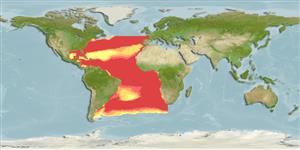Common names from other countries
>
Scombriformes (Mackerels) >
Bramidae (Pomfrets)
Etymology: Taractichthys: Greek, taraktes = confusion; for the pletora of names that have been applied to this fish + Greek, ichthys = fish (Ref. 45335); longipinnis: longipinnis meaning long-finned (Ref. 4525).
More on author: Lowe.
Environment: milieu / climate zone / depth range / distribution range
экология
морской; мигрирует в океане (Ref. 51243); пределы глубины 0 - 500 m (Ref. 89422), usually 42 - 200 m (Ref. 82736). Subtropical; 10°C - ? (Ref. 82736); 47°N - 68°S, 98°W - 21°E
Eastern Atlantic: Iceland and Norway southward to off Pointe Noire, Gulf of Guinea and Namibia; questionably reaching False Bay, South Africa (Ref. 4388). Absent from the Mediterranean (Ref. 4936). Western Atlantic: Nova Scotia, Canada and northern Gulf of Mexico to Puerto Rico (Ref. 7251), Bermuda, northern South America to southeastern Brazil (Ref. 82736). Highly migratory species.
Size / Вес / Возраст
Maturity: Lm ? range ? - ? cm
Max length : 100.0 cm SL самец/пол неопределен; (Ref. 6697)
колючие лучи спинного плавника (общее число) : 0; членистые (мягкие) лучи спинного плавника (общее число) : 33 - 38; колючие лучи анального плавника: 0; членистые (мягкие) лучи анального плавника: 27 - 30. Grey or silvery in color, with coppery reflections (Ref. 4388).
Generally oceanic and presumably epipelagic. Often solitary but occasionally found in small schools close to shore (Ref. 82736). Feed on shrimps and squids (Ref. 82736). Young are present in all seasons (Ref. 6697). Flesh considered very good (Ref. 3576).
Life cycle and mating behavior
Maturities | размножение | Spawnings | Egg(s) | Fecundities | личинки
Gomes, J., 1990. Bramidae. p. 758-764. In J.C. Quero, J.C. Hureau, C. Karrer, A. Post and L. Saldanha (eds.) Check-list of the fishes of the eastern tropical Atlantic (CLOFETA). JNCT, Lisbon; SEI, Paris; and UNESCO, Paris. Vol. 2. (Ref. 4936)
Статус Красного Списка МСОП (Ref. 130435)
CITES (Ref. 128078)
Not Evaluated
Угроза для людей
Harmless
Использование человеком
рыболовство: не имеет хозяйственного значения
дополнительная информация
инструменты
Специальные отчеты
Скачать в формате XML
ресурсы в Интернет
Estimates based on models
Preferred temperature (Ref.
115969): 8 - 26.3, mean 17.6 (based on 589 cells).
Phylogenetic diversity index (Ref.
82804): PD
50 = 0.7500 [Uniqueness, from 0.5 = low to 2.0 = high].
Bayesian length-weight: a=0.01820 (0.00782 - 0.04232), b=2.96 (2.76 - 3.16), in cm Total Length, based on LWR estimates for this (Sub)family-body shape (Ref.
93245).
Trophic level (Ref.
69278): 4.5 ±0.62 se; based on food items.
устойчивость к внешним воздействиям (Ref.
120179): очень низкий, минимальное время удвоения популяции более 14 лет (Preliminary K or Fecundity.).
Fishing Vulnerability (Ref.
59153): High to very high vulnerability (73 of 100).
